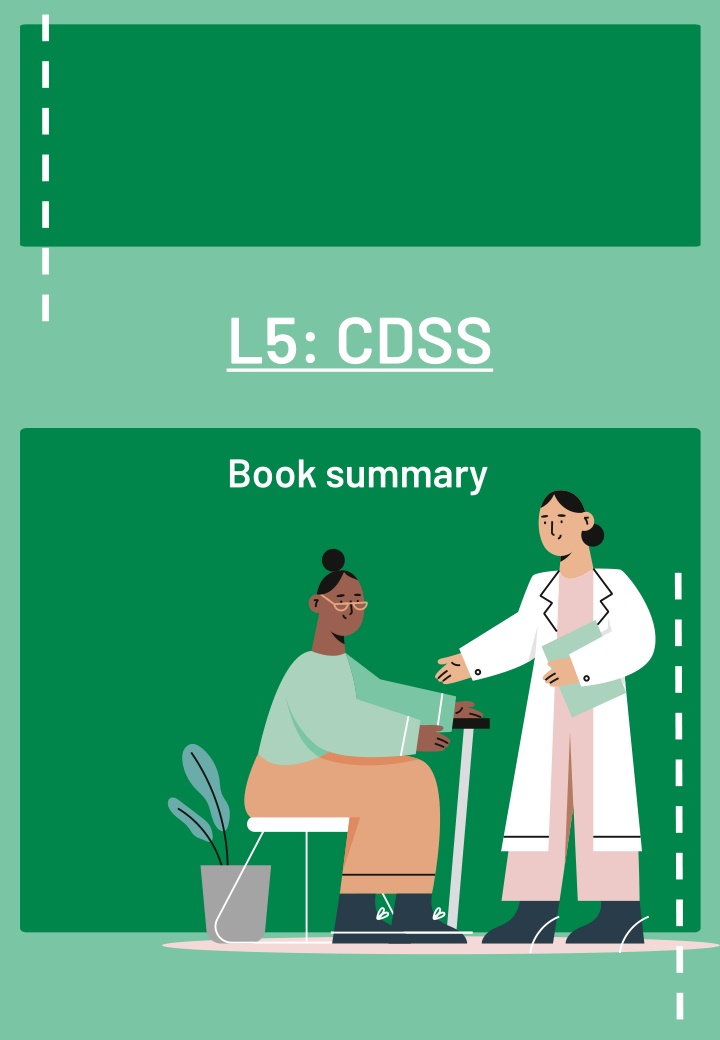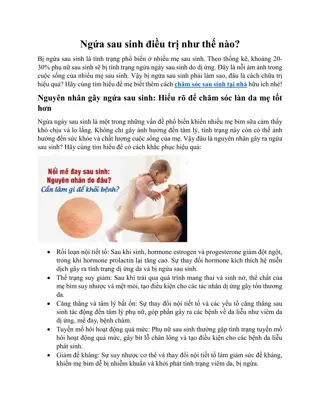
Clinical Decision Support Systems: Tools and Initiatives
Explore examples of Clinical Decision Support tools such as QMR, HELP, Iliad, SimulConsult, as well as initiatives like ONC, AHRQ, HL7, and CMS. Learn about knowledge-based and non-knowledge-based CDS approaches, including knowledge acquisition, representation, rules-based systems, Bayesian networks, and more.
Download Presentation

Please find below an Image/Link to download the presentation.
The content on the website is provided AS IS for your information and personal use only. It may not be sold, licensed, or shared on other websites without obtaining consent from the author. If you encounter any issues during the download, it is possible that the publisher has removed the file from their server.
You are allowed to download the files provided on this website for personal or commercial use, subject to the condition that they are used lawfully. All files are the property of their respective owners.
The content on the website is provided AS IS for your information and personal use only. It may not be sold, licensed, or shared on other websites without obtaining consent from the author.
E N D
Presentation Transcript
L5: CDSS Book summary
Summary of the book Examples of CDS tools CDS Tool name Approach used Purpose QMR Extensive knowledge base of diagnoses, symptoms and lab findings (Quick Medical Reference) A diagnostic CDDS HELP It provides alerts and reminders, data interpretation, diagnostic help, management suggestions and clinical practice guidelines. (Health Evaluation Through Logical Processing) A diagnostic CDSS and reference system for professionals Iliad Useful for children with genetic variants and unusual physical findings where a differential diagnosis is important. Diagnostic program based on Bayesian networks. SimulConsult Supporting Organizations Office of the National Coordinator (ONC): It has 4 tasks: - Task 1: Distill best practices for CDS design and CDS implementation, preparing resources on best practices for broad dissemination through a variety of online channels. - Task 2: Distill best practices and standards for sharing CDS knowledge and produce an open online platform for sharing CDS knowledge artifacts among EHR vendors and/ or provider organizations. - Task 3: Develop a clinically important drug- drug interaction (DDI) list, as well as a legal brief about the liability implications of using the clinically important DDI list. S - Task 4: Develop a process that engages specialty bodies in weighing performance gaps vs. CDS opportunities to select targets for meaningful use of CDS by specialists Agency for Healthcare Research and Quality (AHRQ) : It has multiple CDS initiatives: - The Clinical Decision Support Consortium (CDSC) to assess, define, demonstrate, and evaluate best practices for knowledge management and clinical decision support in healthcare information technology at scale across multiple ambulatory care settings and EHR technology platforms. - Guidelines into Decision Support (GLIDES) translating CPGs into structured data for the outpatient treatment of common diseases. - CDS eRecommendations project - CDS Key Resources - US Health Information Knowledgebase (USHIK) is an AHRQ initiative to support knowledge HL7: goals to advance electronic CDS: - Work on CDS standards for knowledge representation, such as, Infobuttons and order sets - Work on patient centered monitoring such as alerts and reminders - Work on population-centric monitoring and management, such as disease surveillance - Work on representation of CPGs - Develop a data model for clinical decision support - Identify existing HL7 messages and triggers for CDS Centers for Medicare and Medicaid Services (CMS) Meaningful Use Program - Responsible for reimbursing eligible physicians and hospitals for meaningful use of certified EHRs. CMSviews clinical decision support to be integral to quality measures and the improvement of patient care
Summary of the book Knowledge based CDS - Knowledge Use - Knowledge Management a. Knowledge Acquisition b. Knowledge Representation i. Configuration: represented by the choices specified by the institution, which maybe context sensitive. 1. Knowledge acquisition involves having the committee in charge of the clinical system 2. Knowledge maintenance, reviewing those choices on some frequency or as problems arise. ii. Table based 1. Knowledge may be acquired from a vendor or CDS Committee 2. Knowledge maintenance involves vendor updates & periodic reviews, in light of patient quality indicators or patient-safety events. iii. Rules based: consists of if-then statements, (e.g. if patient is allergic to sulfa & a sulfa drug is given, then alert will be triggered. Example: MYCIN iv. Bayesian networks: 1. Use forms of Bayes Theorem (conditional probabilities) to calculate the (posterior) probabilities of diseases (or other state of concern), based on the pretest probability, prevalence of each disease, P(Disease), conditioned on patient specific data (such as symptoms). 2. Formula: P(Disease| Test+) = P(Test+ |Disease) x P(Disease) P(Test+) 3. P(Disease| Test+): positive predictive value & P(Test+|Disease): called sensitivity conditional probabilities c. Knowledge Maintenance: i. Means there is a need to keep knowledge up to date, from the level of the program through the committees in charge and to track changes and reasons. Non-Knowledge based CDS Data mining and predictive modeling can be categorized as supervised or unsupervised machine learning. 1. Supervised machine learning: The goal is to narrow the gap between observed and expected observations. a. Neural Networks: i. Input layer receives multiple inputs and in the hidden layer signals are processed and an output is generated to the output layer. ii. Outputs are compared to the target output and training with input-output pairs is repeated until the trained output and desired target output are similar. b. Logistic Regression c. Decision Trees CDS Standards Arden Syntax InfoButtons GEM GELLO Clinical Quality Language (CQL) Guideline Interchange Format (GLIF) Fast Healthcare Interoperability Resources (FHIR)
Summary of the book Logical Steps for CDS Implementation Logical Steps Details Project initiation - - Ensure clinical and non-clinical leadership are onboard and have a shared vision Ensure CDS is synched with organizational goals, patient safety/quality measures and meaningful use objectives Determine the business case/value of CDS for the organization Determine feasibility from a manpower and financial standpoint and acceptance by clinicians Ensure objectives are clear and attainable Identify key stakeholders and assess buy-in Understand that the CDS needs of specialists are different from primary care Assess readiness, EHR capability and IT support Assess the clinical information systems (CISs) involved Assess knowledge management capabilities Assemble the CDS team: clinical leaders, CMIO administrative and nursing leaders, managers EHR vendor and IT experts Identify clinical champions Develop CDS charter - - - - - - - - - - - - Project planning - - - - - - Consider a SWOT analysis (strengths, weaknesses, opportunities and threats) Utilize standard planning tools such as Gantt charts and swim lanes Develop timeline & Decide whether to build or buy CDS content CDS committee should select CDS interventions that fit their vision Be sure to follow the 5 Rights of CDS Map the different processes involved with CDS and be sure they integrate with the clinician s Workflow Determine whether you will measure structure, processes and/or outcomes Plan the intervention: triggers, knowledge base, inference engine and communication means Educate staff and gain their input Design the CDS program for improvement over baseline performance in an important area for the organization. In other words, be sure you can measure outcomes and compare with baseline data Investigate the needed CDS standards required Follow the mandates of change management, e.g. John Kotter s Eight Step Model Communicate goals of CDS project to all affected - - - - - - - Project execution - - - - - Provide adequate training and make CDS training part of EHR training Develop use cases Test and retest the technology: unit, integration and user acceptance testing Decide on incremental roll-out or big bang Provide a mechanism for feedback in the CDS process, as well as formal support Project monitoring and control - - - - - - Use data from feedback, override logs, etc. to modify the system as needed Compare the alert and override rates with national statistics Measure percent of alerts that accomplished desired goals Communicate the benefits and challenges to the end-users as they arise Use tools such as the AHRQ Health IT Evaluation ToolKit Knowledge management maintenance; are guidelines unambiguous and up to date?
Summary of the book Lesson Learned Lesson Learned Comments Project initiation Ensure the organization can support a new CDS initiative. Even if CDS is intended to match meaningful use, it must be embraced by all and match organizational goals - - Healthcare organizations have competing priorities CDS cannot come from external mandate Project planning - - - - Customization of content and workflow is important One size CDS does not fit all CDS must match the 5 Rights of CDS Make CDS as non-intrusive and non-interruptive as possible Ideally, there should be recommendations for clinicians and patients Interventions should include a reason for overrides Intervention should make recommendation and not just assessment Do CDS with users, not to them EHR data must be up to date for triggers to work correctly Customization is desirable but labor intensive and not available at smaller organizations. Specialists and primary care clinicians have different needs. Clinicians do not want to stop and speed is important. - - - - - Project execution - - - Feedback buttons in CDS work well Include CDS training into EHR training CDS must be tested for UACs and patient safety User feedback is critical Project monitoring and control There may have to be a separate knowledge management committee - - Knowledge management is time consuming Be sure intervention content is up to date






















